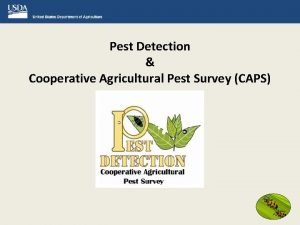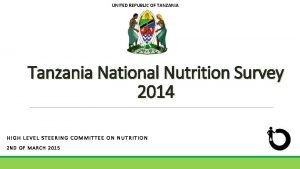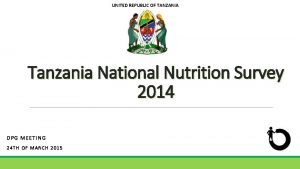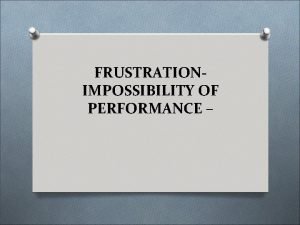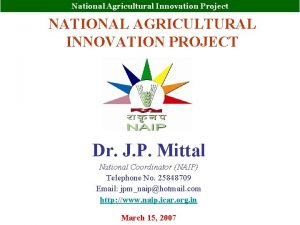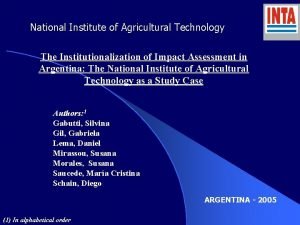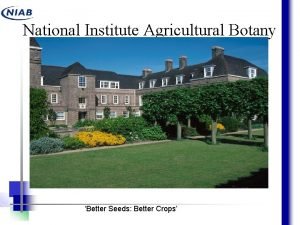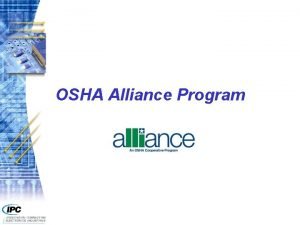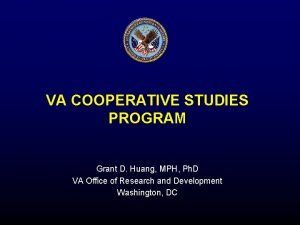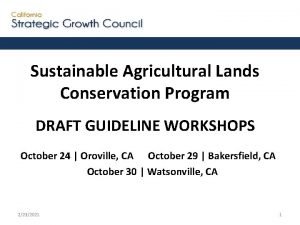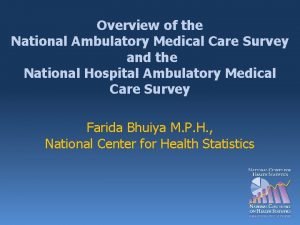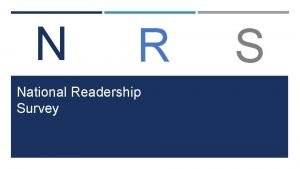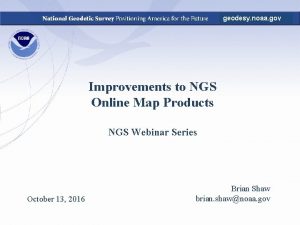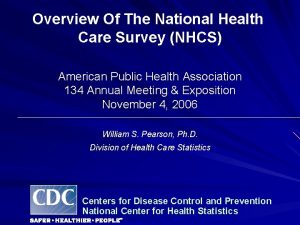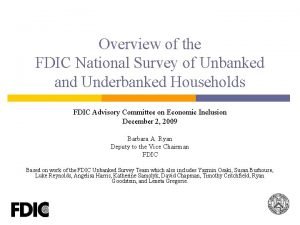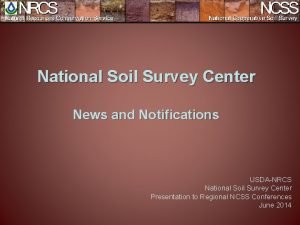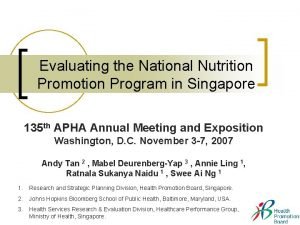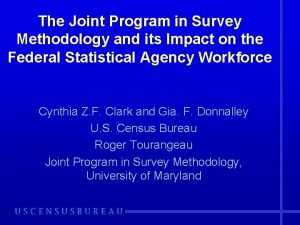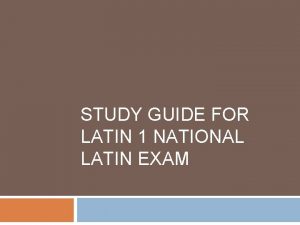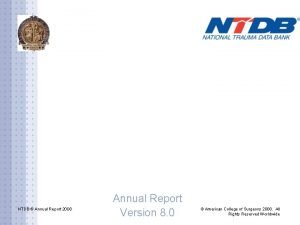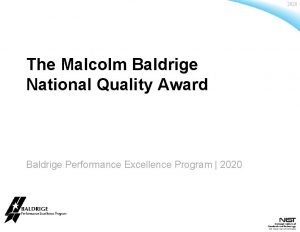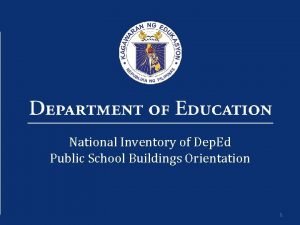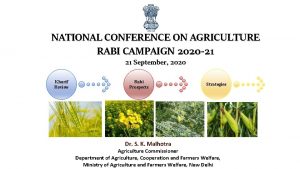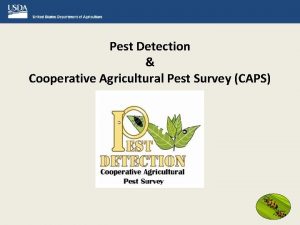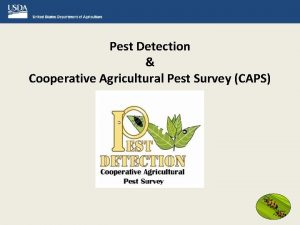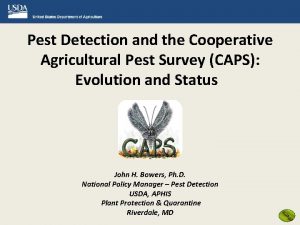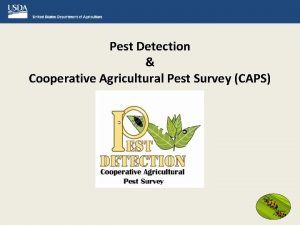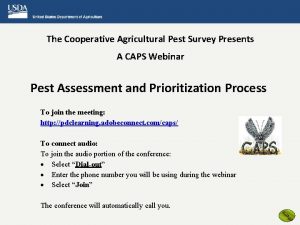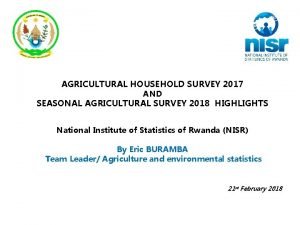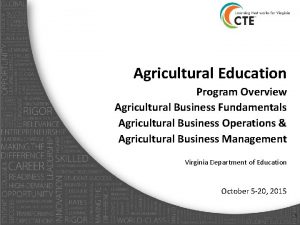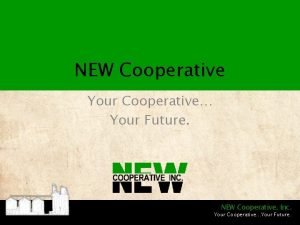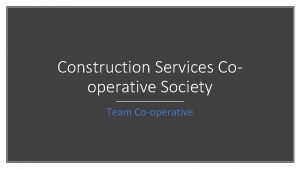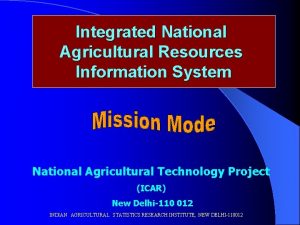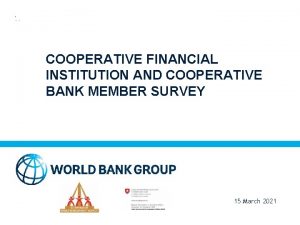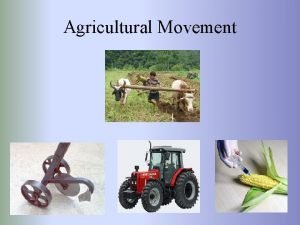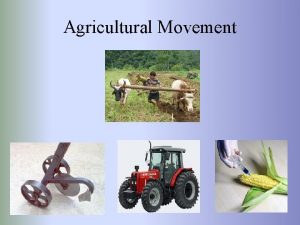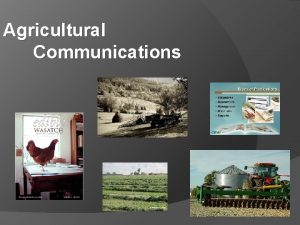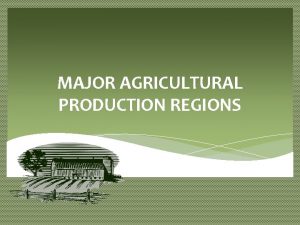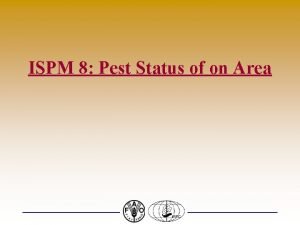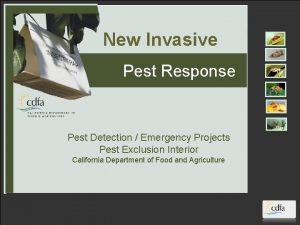The Cooperative Agricultural Pest Survey Program 2020 National






























































- Slides: 62

The Cooperative Agricultural Pest Survey Program: 2020 National Pest Surveillance Guidelines • John Bowers, PM ― National Policy Manager • Lisa Jackson, FO ― National Operations Manager • Heather Moylett, S&T ― CAPS Science Support • Cindy Music, Purdue Univ. ― CAPSIS User Support

2020 National Pest Surveillance Guidelines Pest List & Approved Methods: Updates for 2020 Heather Moylett Heather. Moylett@usda. gov S&TCAPS@usda. gov

2020 Pest List Changes

Priority Pest List

Priority Pest List A pest is removed if it: • is established in the United States, • is federally deregulated, or • is predicted to cause low impacts in the United States. Pests without effective survey or identification/diagnostic methods are removed until methods are available.

Seventeen organisms removed from 2020 Priority Pest List Five federally deregulated or present in United States Agrilus auroguttatus Enarmonia formosana Orthotomicus erosus Paratachardina pseudolobata Phytomyza gymnostoma

Seventeen organisms removed from 2020 Priority Pest List Twelve predicted to cause low impact in the United States Archips xylosteanus Meloidogyne minor Argyresthia pruniella Monilinia polystroma Chlorophorus strobilicola Phytophthora quercina Eutetranychus orientalis Rathayibacter toxicus Heterodera latipons Sclerophthora rayssiae var. zeae Heterodera sacchari Tortrix viridana

Bundling Criteria for CAPS and PPA Goal 1 Surveys New guidance for bundling pests removed from the Priority Pest List Reason removed Bundling allowed? Lacks effective survey or ID methods NO Federally deregulated or established in U. S. Effective survey and ID YES Lacking effective survey or ID NO Predicted to cause low impact in the U. S. Effective survey and ID Requires NOM Review Lacking effective survey or ID NO

Bundling Criteria for CAPS and PPA Goal 1 Surveys No effective AMPS DO NOT BUNDLE

Bundling Criteria for CAPS and PPA Goal 1 Surveys

Bundling Criteria for CAPS and PPA Goal 1 Surveys

Questions?

Approved Methods for Pest Surveillance 2019 & 2020

Fluon-coated traps In stock: Fluon-coated cross vane panel & multi-funnel traps Trap Product Names will not change in the IPHIS Survey Supply Ordering System Cross Vane Panel Trap, Black Multi-funnel Trap, 8 Funnel, Wet Black Multi-funnel Trap, 12 Funnel, Wet Inventory is limited – not possible to replace all traps yet. A fluon trap care guide will be developed soon.

Fluon-coated traps Fluon-coated cross vane panel traps • 2019 orders will receive fluon-coated cross vane panel traps • Required for Callidiellum villosulum (brown fir longhorned beetle) and Trichoferus campestris (velvet longhorned beetle). o May order new traps if surveying for these targets • Other targets, continue to use the traps you have if in good condition. Fluon-coated multi-funnel traps • Deplete untreated stock first. 2019 orders will likely receive uncoated multi-funnel traps. • Not required for any CAPS pests at this time. Continue to use the traps you have if in good condition.

Dendrolimus pini (pine-tree lappet) / D. sibiricus (Siberian silk moth) Approved Trap: modified milk carton trap + funnel insert Milk Carton Funnel Insert available for 2019 Funnel insert is reusable

Dendrolimus pini (pine-tree lappet) / D. sibiricus (Siberian silk moth) If milk carton trap corners tear when inserting new funnels trim 1 -2 mm of material from each corner of the funnel insert. Original Photos courtesy of Dale Anderson Modified

Dendrolimus pini (pine-tree lappet) / D. sibiricus (Siberian silk moth) “Guidance for modified milk carton trap with funnel insert” available on the D. pini and D. sibiricus pest pages on CAPS website. Includes trap assembly, pesticide strip and lure placement, funnel insert modification, and sample collection.

Callidiellum villosulum (brown fir longhorned beetle) Callidiellum Lure available for 2019 Approved survey method: • Lure: Callidiellum Lure • Trap: Cross Vane Panel Trap, Black* Effective for: • Callidiellum villosulum (target pest) • Callidiellum rufipenne (Japanese cedar longhorned beetle) *treated with fluoropolymer

Trichoferus campestris (velvet longhorned beetle) Trichoferus campestris lure added as an approve lure for 2019 Approved survey method: 2019 o Lure: Ethanol or Trichoferus campestris lure o Cross Vane Panel Trap, Black* 2020 o Lure: Trichoferus campestris lure o Cross Vane Panel Trap, Black* *treated with fluoropolymer

Chilo partellus (spotted stem borer) New trap approved – effective 2019 Large Plastic Delta Trap Approved survey method: Lure: Chilo partellus Lure Trap: o Wing Trap Kit, Paper or Plastic o Large Plastic Delta Trap, Orange, Red, or White Delta trap color or wing trap material (paper or plastic) is up to the State and does not affect trap efficacy for this species.

Epiphyas postvittana (LBAM) Light Brown Apple Moth (LBAM) Program approved change in lure formulation for Epiphyas postvittana Lure Previous lure was two-component pheromone blend. Recent research shows four-component lure is more sensitive and may detect new LBAM populations at lower numbers. CA and New Zealand trials: 2 – 5 x higher catch over two component. FY 19 and on, all Epiphyas postvittana Lure ordered will contain the four-component pheromone blend.

Thaumetopoea pityocampa Changes to Thaumetopoea pityocampa Lure received in 2019: Dispenser: polyethylene vial Length of efficacy: 26 weeks Attach dispenser to trap using metal wire. Wrap wire around vial tightly. Do not thread wire through vial hinge. Do not open or puncture vial. Remains effective for two years if stored in freezer.

Questions?

2020 National Pest Surveillance Guidelines Work Plan Process, Expectations, and Review: Updates for 2020 Lisa Jackson Lisa. D. Jackson@usda. gov

Work Plan Process, Expectations, and Review: Updates for 2020 Topics • Changes to work plan • Work Plan Review – expectations going forward o Survey Summary Form o Bundled Pest Guidance o Accountability Report • Work Plan Process o Review process o Roles and responsibilities

Changes to the Work and Financial Plan Contractual Costs Ø A second Financial Plan is now required to describe and detail all contractual costs. • Contractual items listed in the Financial Form must be described in an additional Financial Form. • A separate Contractual Financial Form is provided in the file to list Contractual costs.

Work Plan Review – Expectations • The current year template (now marked with the year) will have to be used; • The Survey Summary Form (SSF) o o o Surveys and target pests must match between the work plan and SSF. As we begin to implement the online work plan (2021), this step will be much easier. Work plans are often submitted and uploaded to Share. Point well before the SSF has been completed (many weeks in some cases). The NOM will not review the work plan until the SSF has been completed. SPHDs, please remind your SSCs to submit the SSF when they submit their work plan. SSCs, please remind your PSS or SPHD to approve the SSF to move it along to the NOM.

Work Plan Review – Expectations Surveys must follow Bundled Pest Guidance 1. Federally deregulated pests • If effective survey and identification/diagnostic methods are available, the pest may be bundled. • If the pest does not have an effective survey or identification/diagnostic method, then the pest should not be bundled.

Work Plan Review – Expectations Surveys must follow Bundled Pest Guidance 2. Pests without effective survey or identification/diagnostic methods • If the pest was removed from the Priority Pest List because it does not have an effective survey or identification/diagnostic method, then the pest should not be bundled. • Pests that are predicted to cause high impact are placed on a priority list for research and methods development. • Once effective methods are available, the pest will return to the Priority Pest List.

Work Plan Review – Expectations Surveys must follow Bundled Pest Guidance 3. Current Priority Pests predicted to cause low impact • These organisms were added to the Priority Pest List before the Impact Assessment was adopted for prioritizing pests. • The pests have been evaluated by the Impact Assessment and are predicted to cause low impact. • It is strongly encouraged that low impact pests not be bundled into surveys. • If this were a new pest suggestion, the pest would not be added to the list. • If a pest in this category is bundled into a survey, the National Operations Manager for Pest Detection will reach out to the cooperator to ensure there are specific reasons why this pest should be bundled (trade concerns, etc. ).

Data entered and the Accountability Report is complete • Before submitting a new work and financial plan, the ADODR should check the Accountability Report on the CAPS Resource & Collaboration website to ensure data from previous years surveys have been entered into the appropriate database (NAPIS). o o o For review of a 2020 work plan (CAPS and PPA 7721), the ADODR should check and determine that all 2018 and earlier data from the cooperator has been entered into NAPIS. Surveys for 2019 are in progress, and all the 2019 data is not expected to be available when 2020 work plans are due. However, 2018 and earlier data should be available and properly entered into NAPIS.

Data entered and the Accountability Report is complete • On the Accountability Report, the state should have a check mark by the year if data for all pests has been entered.

Data entered and the Accountability Report is complete • A blank space means that no data has been entered for any targets. • A dash mean that data has been entered for some targets, but some data is missing.

Data entered and the Accountability Report is complete • To see more specific details on the state, click on the arrow by the state name. • You will then see each survey listed, with all targets within that survey. • For each target, there should be either a number in the Positive or Negative fields and a date in the Activity field.

Data entered and the Accountability Report is complete • In this example, some targets have data and some do not.

Data entered and the Accountability Report is complete • If the data has not been entered, the ADODR should communicate this deficiency to the cooperator. • Once the missing data is entered, or an acceptable justification is provided, submission of new work and financial plans may proceed. • New work plans will not be processed until data entry requirements are met. • CAPSIS is working on a feature on the Accountability Report that would allow a state to designate a “Pending” status. The SSC would need to enter: 1) The reason why the data is pending; 2) The expected date of resolution.

Work Plan Process Work Plans and Survey Summary Form (SSF) • State Survey Coordinator (SSC) completes SSF while completing work plan. • SSC, SPRO, SPHD, and PSS finalize work plan • SPHD should review the Accountability Report for data from previous years’ surveys. • SSC submits SSF for SPHD and PSS review • SPHD/PSS review SSF: o Survey names and targets should match what is in work plan. • SPHD/PSS clicks on the “request a decision” link. • This submits the form for National Operations Manager review. • An email is sent each time the SSF status moves to a new step in the workflow.

Work Plan Process Work Plans and Survey Summary Form (SSF) • SPHD uploads work plans to Cooperative Agreements Share. Point site. • SPHD emails the National Operations Manager (NOM) that the work plans have been uploaded and are ready for review. • In the email, SPHD verifies that he/she has checked the Accountability Report. • Once both the SSF and work plans are final, the NOM will review the work plans and Survey Summary Forms.

Work Plan Process Work Plans and Survey Summary Form (SSF) • NOM reviews the work plans in the order that the work plan was uploaded and the SSF has been completed. • NOM will email the SPHD either to say the plan is approved or that revisions are necessary. • For CAPS only: o The status of work plans will not change in Share. Point until we receive a notification from the budget staff to begin processing agreements (likely in November). o At that time, the NOM will change the status of the work plans to “FOM Approved” and notify the agreements staff. o The agreements staff will begin entering the “opportunities” into ez. Fed. Grants.

Questions?

2020 National Pest Surveillance Guidelines Survey Names for CAPS and PPA Goal 1 Survey: Updates for 2020 John Bowers John. Bowers@usda. gov

Guidance for Selecting Survey Names • Surveys Conducted in One Crop o Choose that crop as a survey name o Do not try to fit it into a Commodity Survey when the survey crop is not listed in the commodity manual o E. g. , if the survey crop is rice, choose Rice Pest Survey, not Small Grains o Host/Habitat field also should designate Rice Ø The Host/Habitat field works with the Survey Name to allow efficient and effecting reporting

Guidance for Selecting Survey Names • Surveys Conducted in Multiple Crops o Choose a survey name that reflects or covers most of the crops, not just one o E. g. , if surveys will be conducted in soybeans and corn, choose Field Crops Pests, not Corn or Soybeans o Specify the different host/crops in the Host/Habitat field o Do not try to fit a survey under an existing Designed Commodity Survey when another, more encompassing name is a better fit.

Guidance for Selecting Survey Names • Surveys conducted in Crops that Fall Under an Existing Designed Commodity Survey o Use the commodity survey as the survey name o E. g. , if the survey will be conducted in tomato, eggplant, potato, and pepper, then use Solanaceous Commodity Survey o Specify the different host/crops in the Host/Habitat field • However, if the survey will be conducted solely in one commodity of an existing multiple commodity survey o Follow the previous guidance and choose the single crop or commodity as the survey name

Questions?

2020 National Pest Surveillance Guidelines Survey Planning & Change Requests: Updates for 2020 Cindy Music clmusic@purdue. edu CAPSIS@purdue. edu

Ø CAPS Survey Summary Form Ø Farm Bill/PPA 7721 Survey Summary Form Ø PPQ Survey Summary Form


Survey Summary Form Set Year, Funding Source Add Survey Interface, Submit Request a Review

Survey Summary Form § Add target(s) Add additional survey(s) Fill in interface Request a review

Workflow = Status

Mobile version

Change Request Set Funding Year, Source “Request Modification” Detailed Request Status in Workflow, emails Approved - Edit, Save, Submit

Questions?

2020 National Pest Surveillance Guidelines Data Entry: Roles & Responsibilities: Updates for 2020 John Bowers John. Bowers@usda. gov

Where Does Information/Data Go and Who Is Responsible • SPHDs, SPROs, PSSs, and SSCs • Survey Summary Form (SSF) • National Agricultural Pest Information System (NAPIS) CAPS Data • Collected by the SSC and/or other State survey staff under a Pest Detection cooperative agreement • SSC’s responsibility to enter survey information into the SSF, and prepare and upload survey results into NAPIS

Where Does Information/Data Go and Who Is Responsible PPQ Pest Detection Data • Collected by the PSS or other PPQ staff • PSS’s responsibility to enter survey information into the SSF • Prepare survey results in the correct format to share with the SSC for upload into NAPIS PPA 7721 Goal 1 Survey*; Traditional CAPS Cooperator • Collected by the SSC and/or other State survey staff under a PPA 7721 cooperative agreement • SSC’s responsibility to enter survey information into the SSF, and prepare and upload survey results into NAPIS *For National Priority Surveys

Where Does Information/Data Go and Who Is Responsible PPA Goal 1 Survey*; Non-Traditional Cooperator • Collected by individuals, organizations, or institutions, other than those that traditionally participate in the CAPS program, under a PPA 7721 cooperative agreement • The cooperator will prepare survey information and survey results in the correct format, and share with or send to the SSC for entry into the SSF and upload into NAPIS • The SPHD/SPRO/PSS should aid the SSC in identifying and reaching out to these cooperators in their State • The SSC should provide the cooperator with survey templates before the survey season begins See process in Data Entry Roles and Responsibilities

Where Does Information/Data Go and Who Is Responsible PPQ Pest Programs & PPA Non-National Priority Surveys • Collected by the SSC and/or other State survey staff under a PPQ Pest Program or PPA 7721 cooperative agreement (not Pest Detection or PPA National Priority Survey) o e. g. , Gypsy Moth, Fruit Flies, EAB, ALB, SLF, etc. • No SSF entry • Survey results should be entered into the required database as directed by the Program • No NAPIS entry required, but may be entered into NAPIS if the SPRO, SPHD, PSS, and SSC determine that this is appropriate

Where Does Information/Data Go and Who Is Responsible Other PPQ Pest Programs (by PPQ Staff) • Survey work is performed by PPQ staff for PPQ Pest Programs other than Pest Detection • No SSF entry • Survey results should be entered into the required database as directed by the Program • No NAPIS entry required, but may be entered into NAPIS if the SPRO, SPHD, PSS, and SSC determine that this is appropriate o PSS should prepare the data in the correct format, and share with or send to the SSC for upload into NAPIS

Questions?
 Cooperative agricultural pest survey
Cooperative agricultural pest survey Tanzania national nutrition survey 2019
Tanzania national nutrition survey 2019 Tanzania national nutrition survey 2020
Tanzania national nutrition survey 2020 What is frustration in psychology
What is frustration in psychology National agricultural innovation project
National agricultural innovation project National institute of agricultural technology
National institute of agricultural technology National institute of agricultural botany
National institute of agricultural botany Nsa cooperative education program
Nsa cooperative education program Osha alliance program
Osha alliance program Va cooperative studies program
Va cooperative studies program 叫叫abcde
叫叫abcde Sustainable agricultural lands conservation program
Sustainable agricultural lands conservation program European working conditions survey 2020
European working conditions survey 2020 National hospital ambulatory medical care survey
National hospital ambulatory medical care survey Pamco survey
Pamco survey Ngs data explorer
Ngs data explorer National hospital care survey
National hospital care survey National survey of unbanked and underbanked households
National survey of unbanked and underbanked households National soil survey center
National soil survey center Singapore national nutrition survey
Singapore national nutrition survey Survey methodology phd programs
Survey methodology phd programs Latin 1 final exam answers
Latin 1 final exam answers National trauma data bank annual report 2020
National trauma data bank annual report 2020 Six key ministerial priorities
Six key ministerial priorities Malcolm baldrige national quality award 2020
Malcolm baldrige national quality award 2020 School building inventory form deped
School building inventory form deped National conference for rabi campaign 2020
National conference for rabi campaign 2020 Hình ảnh bộ gõ cơ thể búng tay
Hình ảnh bộ gõ cơ thể búng tay Lp html
Lp html Bổ thể
Bổ thể Tỉ lệ cơ thể trẻ em
Tỉ lệ cơ thể trẻ em Gấu đi như thế nào
Gấu đi như thế nào Thang điểm glasgow
Thang điểm glasgow Chúa yêu trần thế alleluia
Chúa yêu trần thế alleluia Các môn thể thao bắt đầu bằng tiếng chạy
Các môn thể thao bắt đầu bằng tiếng chạy Thế nào là hệ số cao nhất
Thế nào là hệ số cao nhất Các châu lục và đại dương trên thế giới
Các châu lục và đại dương trên thế giới Công thức tính độ biến thiên đông lượng
Công thức tính độ biến thiên đông lượng Trời xanh đây là của chúng ta thể thơ
Trời xanh đây là của chúng ta thể thơ Cách giải mật thư tọa độ
Cách giải mật thư tọa độ Phép trừ bù
Phép trừ bù Phản ứng thế ankan
Phản ứng thế ankan Các châu lục và đại dương trên thế giới
Các châu lục và đại dương trên thế giới Thể thơ truyền thống
Thể thơ truyền thống Quá trình desamine hóa có thể tạo ra
Quá trình desamine hóa có thể tạo ra Một số thể thơ truyền thống
Một số thể thơ truyền thống Cái miệng bé xinh thế chỉ nói điều hay thôi
Cái miệng bé xinh thế chỉ nói điều hay thôi Vẽ hình chiếu vuông góc của vật thể sau
Vẽ hình chiếu vuông góc của vật thể sau Biện pháp chống mỏi cơ
Biện pháp chống mỏi cơ đặc điểm cơ thể của người tối cổ
đặc điểm cơ thể của người tối cổ Ví dụ giọng cùng tên
Ví dụ giọng cùng tên Vẽ hình chiếu đứng bằng cạnh của vật thể
Vẽ hình chiếu đứng bằng cạnh của vật thể Vẽ hình chiếu vuông góc của vật thể sau
Vẽ hình chiếu vuông góc của vật thể sau Thẻ vin
Thẻ vin đại từ thay thế
đại từ thay thế điện thế nghỉ
điện thế nghỉ Tư thế ngồi viết
Tư thế ngồi viết Diễn thế sinh thái là
Diễn thế sinh thái là Dot
Dot Số nguyên tố là số gì
Số nguyên tố là số gì Tư thế ngồi viết
Tư thế ngồi viết Lời thề hippocrates
Lời thề hippocrates Thiếu nhi thế giới liên hoan
Thiếu nhi thế giới liên hoan
